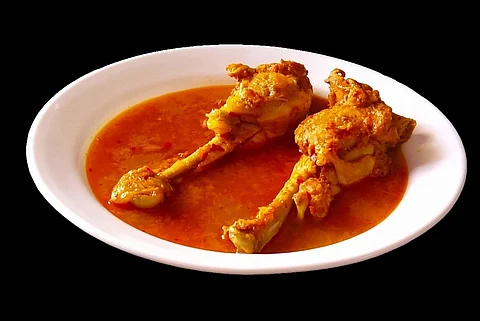
- Destinations
- Experiences
- Stay
- What's new
- Editor’s Picks
- Responsible Tourism
- CampaignsCampaigns
- Subscribe

While Bengali cuisine continues to be identified with fish curry, and the quintessential rosogolla, there&rsquos much more to the gastronomic fare of the Bengal delta including some rare delicacies like the Goalondo Steamer Fowl Curry.
In the second half of the 19th century, it was decided to extend a line of the Eastern Bengal Railway to Goalondo Ghat. Located at the meeting point of the rivers Padma and Brahmaputra, Goalondo was a key river transportation hub, visited by mail boats, cargo boats as well as passenger ferries.
From the late 19th century, those travelling from Kolkata to Dakha in East Bengal (now Bangladesh) or Assam would travel by train to Goalondo, from where they would take the steamer to Narayanganj, and again take the train for onward journey to Dhaka, Sylhet or Chittagong (all in Bangladesh now)  and parts of Assam.
The boatmen would cook their meal aboard the ferry. In their makeshift kitchen, the &lsquokhalasi&rsquo would prepare rice and a chicken curry to go with it. They used the simplest of ingredients, such as mustard oil, red chillies, onion and garlic, to prepare the chicken curry. Apparently, the passengers, drawn by the aroma of the rice and curry, would ask to share. Later, the meal would be sold on board.
With time, what was a simple meal sered aboard the steamer, became known as the Goalondo Chicken Curry or Steamer Chicken Curry.
Famous Bengali writer and scholar Syed Mujtaba Ali, perhaps the earliest food writer from undivided Bengal, often mentioned about a murgir jhol (chicken curry) being served at the steamers heading towards Narayanganj. In fact, in one of his musings, Ali rued, &ldquoI am amazed that the young girl from Bikrampur (the women of Bikrampur were reputed to be the finest cooks in all of Bengal) travels to her college hostel in Calcutta on the Goalondo steamer, dining on rice and curry on board, yet has never been able to produce the Steamer Fowl Curry cooked by the simple boatmen.&rdquo
Noted journalist, food historian and culinary critic Pritha Sen has drafted a beautiful narrative about this dish.
Shawkat Osman, Dhaka-based renowned historian and food researcher too has written about this rustic non-vegetarian dish. In his celebrated work on the cuisine from present-day Bangladesh, titled Khunti Korai &ndash Bangladeshi Cuisine, 2009, (Korai is kadhai or wok and khunti is spatula) referring to this rustic boatmen&rsquos curry, he states&mdash&ldquoIt is our very own &lsquoMurgir Salon&rsquo or salan cooked in every household but in the steamers and in the many ghats across the country, small eateries cook the same with a generous helping of dry chilies.&rdquo
Even the-then publications like the Bengal Gazette, Imperial Gazetteer, old journals of forest officers and tea planters often mentioned about the fiery yet light chicken curry being served on the steamer that travelled from Goalondo till Narayanganj.
One common thread that Sen found among all the literary canons, was &ldquofiery thin red curry with oil floating on top.&rdquo
Later interpolations or inventions also led to the addition of potatoes and hard-boiled eggs.
However, the original one definitely had its own charm. Explaining the folklore and historical account behind the legendary dish, Sen says, &ldquoNo recipe can be categorised as completely lost. I believe the same is applicable for the Goalondou Steamer Fowl Curry.&rdquo She goes onto say that with transportation in the region were affected to some extent post-independence and eventually train services were also discontinued.
Needless to say the steamer travel also met with the same fate. However, the memories of the Goalondo (also Goalondou) fowl curry were not erased easily.
What makes the dish so tasteful What is the secret behind its recipe According to Siddhartha Bose, owner of the popular Bengali restaurant chain Bhojohori Manna, &ldquoAuthentic recipe of the dish might be somewhat difficult to come by.&rdquo However, various influences&ndash especially Europeans, British and Portuguese, may have added to the already existing rustic flavours of the dish, he said.
Kolkata-based well-known food writer and blogger Indrajit Lahiri said, &ldquoThere is almost no authentic documented recipe for the same. But many have tried to recreate the dish using simple ingredients found in the home kitchen. Many recipe bloggers and home chefs have tried their hands on it and are pretty good at it, as well. But then, how can a simple chicken curry, cooked with love, go wrong&rdquo
Indrani Mukherjee, a Bangalore-based technical writer and a food blogger said, &ldquoIt is the rustic element attached to the dish and of course the extra serving of dry red chillies and mustard oil gives it a unique twist.&rdquo
A few restaurants in Kolkata serve this dish among them Bose&rsquos Bhojohori Manna and Aaheli by Peerless Inn are worth mentioning. However, Bose reminded that the Steamer Curry is not for the masses. It has its own niche customers.
Over time, its popularity might have faded, but the sleepy town of Goalondou, in Bangladesh, roughly 90 kilometres away from capital Dhaka, still remain an alive as a tourist destination albeit popular for the famous steamer fowl curry.
The main image is by Samrat Roy Chowdhuri, techie and food blogger. You can find out more about the steamer chicken curry (and the recipe) on his blog here.
This article is a submission by one of our readers, and part of our series #OTReadersWrite. Have a great travel story to tell Write to us at letters@outlooktraveller.com.
